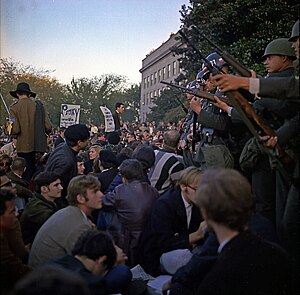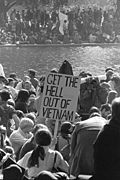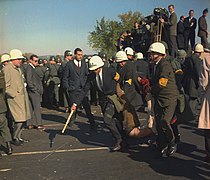
Abbot Howard Hoffman was an American political and social activist who co-founded the Youth International Party ("Yippies") and was a member of the Chicago Seven. He was also a leading proponent of the Flower Power movement.

Jerry Clyde Rubin was an American social activist, anti-war leader, and counterculture icon during the 1960s and early 1970s. Despite being known for holding radical views when he was a political activist, he ceased holding his more extreme views at some point in the 1970s and instead opted for a successful career as a businessman. In the 1960s, during his political activism heyday, he was known for being one of the co-founders of the Youth International Party (YIP) whose members were referred to as Yippies, and standing trial in the Chicago Seven case.

The Youth International Party (YIP), whose members were commonly called Yippies, was an American youth-oriented radical and countercultural revolutionary offshoot of the free speech and anti-war movements of the late 1960s. It was founded on December 31, 1967. They employed theatrical gestures to mock the social status quo, such as advancing a pig as a candidate for president of the United States in 1968. They have been described as a highly theatrical, anti-authoritarian and anarchist youth movement of "symbolic politics".
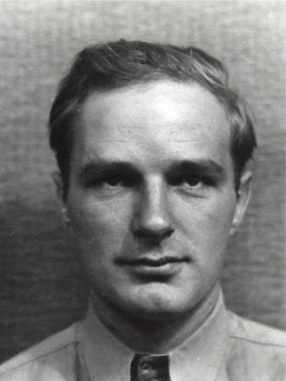
David T. Dellinger was an American pacifist and an activist for nonviolent social change. He achieved peak prominence as one of the Chicago Seven, who were put on trial in 1969.
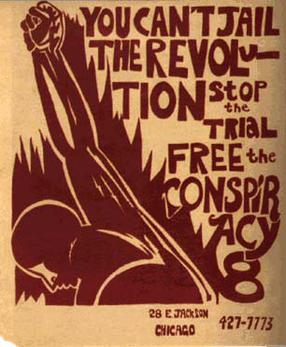
The Chicago Seven, originally the Chicago Eight and also known as the Conspiracy Eight or Conspiracy Seven, were seven defendants – Rennie Davis, David Dellinger, John Froines, Tom Hayden, Abbie Hoffman, Jerry Rubin, and Lee Weiner – charged by the United States Department of Justice with conspiracy, crossing state lines with intent to incite a riot, and other charges related to anti-Vietnam War and 1960s counterculture protests in Chicago, Illinois during the 1968 Democratic National Convention. The Chicago Eight became the Chicago Seven after the case against co-defendant Bobby Seale was declared a mistrial.

Flower power was a slogan used during the late 1960s and early 1970s as a symbol of passive resistance and nonviolence. It is rooted in the opposition movement to the Vietnam War. The expression was coined by the American Beat poet Allen Ginsberg in 1965 as a means to transform war protests into peaceful affirmative spectacles. Hippies embraced the symbolism by dressing in clothing with embroidered flowers and vibrant colors, wearing flowers in their hair, and distributing flowers to the public, becoming known as flower children. The term later became generalized as a modern reference to the hippie movement and so-called counterculture of drugs, psychedelic music, psychedelic art and social permissiveness.

Rennard Cordon Davis was an American anti-war activist who gained prominence in the 1960s. He was one of the Chicago Seven defendants charged for anti-war demonstrations and large-scale protests at the 1968 Democratic National Convention in Chicago. He had a prominent organizational role in the American anti–Vietnam War protest movement of the 1960s.

Flower child originated as a synonym for hippie, especially among the idealistic young people who gathered in San Francisco and the surrounding area during the Summer of Love in 1967. It was the custom of "flower children" to wear and distribute flowers or floral-themed decorations to symbolize ideals of universal belonging, peace, and love. The mass media picked up on the term and used it to refer in a broad sense to any hippie. Flower children were also associated with the flower power political movement, which originated in ideas written by Allen Ginsberg in 1965.

Opposition to United States involvement in the Vietnam War began with demonstrations in 1965 against the escalating role of the United States in the Vietnam War and grew into a broad social movement over the ensuing several years. This movement informed and helped shape the vigorous and polarizing debate, primarily in the United States, during the second half of the 1960s and early 1970s on how to end the Vietnam War.
Pigasus, also known as Pigasus the Immortal and Pigasus J. Pig, was a 145-pound (66 kg) domestic pig that was nominated for President of the United States as a theatrical gesture by the Youth International Party on August 23, 1968, just before the opening of the Democratic National Convention in Chicago, Illinois. The youth-oriented party was an anti-establishment and countercultural revolutionary group whose views were inspired by the free speech and anti-war movements of the 1960s, mainly the opposition to United States involvement in the Vietnam War.
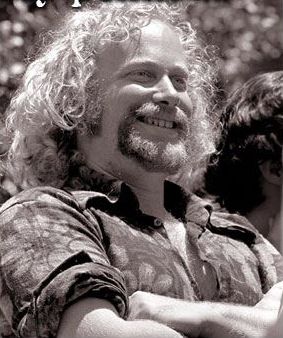
Stewart Edward "Stew" Albert was an early member of the Yippies, an anti-Vietnam War political activist, and an important figure in the New Left movement of the 1960s.
The Spring Mobilization Committee to End the War in Vietnam, which became the National Mobilization Committee to End the War in Vietnam, was a coalition of American antiwar activists formed in November 1966 to organize large demonstrations in opposition to the Vietnam War. The organization was informally known as "the Mobe".
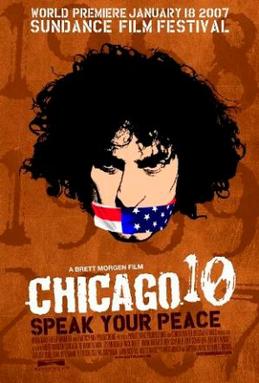
Chicago 10: Speak Your Peace is a 2007 American animated documentary written and directed by Brett Morgen that tells the story of the Chicago Eight. The Chicago Eight were charged by the United States federal government with conspiracy, crossing state lines with intent to incite a riot, and other charges related to anti-Vietnam War and countercultural protests in Chicago, Illinois during the 1968 Democratic National Convention.

The 1968 Democratic National Convention protests were a series of protests against the United States' involvement in the Vietnam War that took place prior to and during the 1968 Democratic National Convention in Chicago, Illinois. The protests lasted approximately seven days, from August 23 to August 29, 1968.

The Ultimate Confrontation: The Flower and the Bayonet is a photograph of Jan Rose Kasmir, at that time an American high-school student. This iconic photograph was taken by French photographer Marc Riboud. Riboud photographed Kasmir on 21 October 1967 while taking part with over 100,000 anti-war activists in the National Mobilization Committee to End the War in Vietnam's March on the Pentagon to protest U.S. involvement in Vietnam. Seventeen-year-old Kasmir was shown clasping a chrysanthemum and gazing at bayonet-wielding soldiers. The photo was featured in the December 30, 1969 special edition of Look magazine under the title The Ultimate Confrontation: The Flower and the Bayonet. The photo was republished world-wide and became a symbol of the flower power movement. Smithsonian Magazine later called it "a gauzy juxtaposition of armed force and flower child innocence".
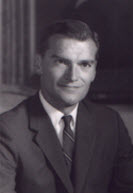
David Eliot McGiffert was a United States lawyer and Pentagon official who dealt with domestic security during the social upheavals of the late 1960s.

Gary Eugene Rader was an American Army Reservist known for burning his draft card in protest of the Vietnam War, while wearing his U.S. Army Special Forces uniform. Afterward, he engaged in anti-war activism.
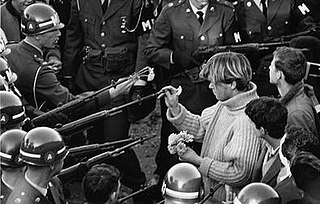
Flower Power is the title of a photograph taken by American photographer Bernie Boston for the now-defunct newspaper The Washington Evening Star. Taken on October 21, 1967, during the March on the Pentagon by the National Mobilization Committee to End the War in Vietnam, the photo shows protester George Harris placing a carnation into the barrel of an M14 rifle held by a soldier of the 503rd Military Police Battalion (Airborne).
Robert M. Ockene was a book editor, anti-war activist, co-founder of the Youth International Party, and a founder of Veterans and Reservists to End the War in Vietnam. He was an editor at Grossman Publishers where he edited and produced the book that brought Ralph Nader to national attention, Unsafe at Any Speed. Later he became an executive editor at Bobbs-Merrill Company.
